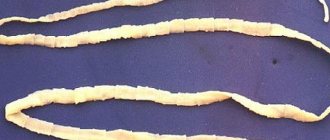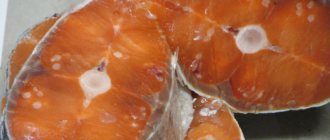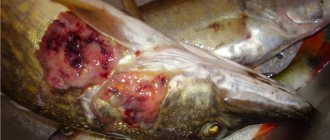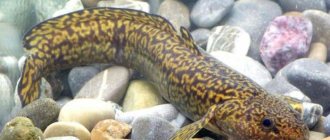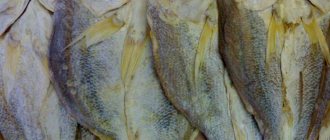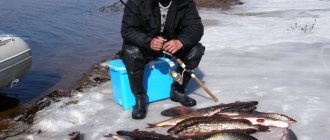Fish parasites are dangerous organisms that can greatly undermine human health. According to statistics, 75% of the world's catch contains parasite eggs; it is often impossible to see them with naked gas and it is possible to determine that the fish is infected only with the help of a microscope. Nevertheless, fish is a very valuable and useful product for the human body, so you should not refuse to eat it, especially since not all helminths in fish are dangerous for people. In addition, with proper preparation, you can protect yourself and your loved ones from negative consequences.
It is important to know fish worms - what they look like (if you can see them), at what temperature the parasites in fish die, how to properly prepare the product to prevent pests from entering the human body.
What to do in such a situation? To get started, we recommend reading this article. This article describes in detail methods of controlling parasites. We also recommend that you consult a specialist. Read the article >>>
What fish have parasites?
People often wonder whether there are parasites in sea fish. It will be a discovery for many, but helminths are found not only in freshwater fish; there are also dangerous worms in sea fish and other seafood. In this case, a parasite can enter the body, which, in principle, does not live in this type of fish.
This happens as a result of large fish feeding on smaller fish. If you follow safe cooking techniques from seafood, all parasites die, and the dish becomes absolutely safe.
Only those who like to enjoy rolls, sushi and other treats that are prepared without heat treatment of the product take risks. They are at risk of anisakids, which will cause problems with the gastrointestinal tract, and subsequently provoke a stomach ulcer. Getting rid of parasites and the diseases they cause will require a lot of time, effort and money, is a piece of roll worth such sacrifices?
Parasites in pollock include Chinese fluke, Siberian fluke, broad tapeworm and some others. Red fish: pink salmon, salmon, chum salmon contain tapeworms, roundworms, cat fluke, phylometroidosis and others.
How to properly process, store and prepare fish to destroy parasites?
To destroy almost any type of parasite in fish, you need to follow fairly simple instructions. Namely:
- Sea fish, if caught in the ocean, should be frozen immediately after catching, and after defrosting, immediately consumed for food, without trying to store it anywhere.
- In most cases, river fish can be eaten only after processing (the exception is sterlet, which can be eaten raw). Salting, pickling or smoking is suitable for processing.
- Any well-cooked or fried fish is absolutely safe. Cooking should last at least 20 minutes after boiling, frying should last at least 15-20 minutes.
- When hot smoking, meat is completely free of parasites by the time it is ready and does not require additional processing.
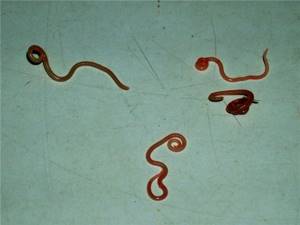
Nematodes parasitizing fish
These recommendations were prepared using the rules of safe freezing and salting in accordance with the Sanitary and Epidemiological Standards “SanPiN” No. 3.2.1333-03 “Prevention of parasitic diseases in the Russian Federation.”
Temperature during freezing
To destroy tapeworm larvae, freezing is carried out according to the following rules:
| Freezing temperature in Celsius: | Pike, burbot, ruff and perch: | Chum salmon, Sima, Sakhalin taimen, pink salmon and kuja: | Peled, whitefish, omul, muksun, char, broad whitefish, tugun, grayling, lake trout: |
| -12 degrees | 72 hours | 60 hours | |
| -15 degrees | 50 hours | ||
| -16 degrees | 36 hours | ||
| -20 degrees | 36 hours | ||
| -22 degrees | 18 hours | ||
| -26 degrees | 16 hours | ||
| -27 degrees | 12 hours | 7 o'clock | |
| -30 degrees | 6 hours |

Massive parasitic infestation of river fish
To destroy opisthorchis larvae, freezing is carried out according to the following rules:
| Freezing temperature in Celsius: | Time required for complete disinfection of fish: |
| -28 degrees | 32 hours |
| -35 degrees | 14 hours |
| -40 degrees | 7 o'clock |
To destroy parasite larvae in marine fish, crustaceans and mollusks, freezing is carried out according to the following rules:
| Freezing temperature in Celsius: | Freezing duration: | Rules for subsequent storage of fish: |
| -18 degrees | 11 days | According to current regulations |
| -20 degrees | 24 hours | At a temperature not exceeding -18 degrees for 7 days, after which, in accordance with current regulations |
| -30 degrees and below | 10 minutes | At a temperature not exceeding -12 degrees for 7 days, after which, in accordance with current regulations |
Worms in fish (video)
Ambassador rules
Temperature and duration of salting:
| Ambassador: | Brine density: | Temperature (in Celsius): | Salting duration: | Mass fraction of salt in the product: |
| Strong | 1,20 | + 2-4 degrees | 14 days | More than 14% |
| Average | 1,18 | + 2-4 degrees | 14 days | 10-14% |
| Weak | 1,16 | + 2-4 degrees | 16 days | 8% |
To destroy tapeworm larvae in fish, it is disinfected by salting according to the following rules:
- to destroy D. luxi larvae in Far Eastern salmon, industrial salting is carried out with a 5% mass fraction of salt in the product;
- to destroy gull tapeworm larvae in whitefish, salmon and grayling fish, light salting is carried out (brine density no more than 1.18-1.19) for 10 days with 8-9% of the mass fraction of salt in the product;
- To destroy trematode larvae (including opisthorchid), mixed strong and medium salting is carried out (brine density no more than 1.20 at +1 or +2 degrees) with 14% mass fraction of salt in the product.
Fish parasites
There are also enough parasites in river fish; most often helminths can be found in grayling; it is not expensive, which means it is in demand among the population. When you cut a grayling, you can often see whiteworm in it. Often nematodes can be seen in the liver of crucian carp; helminth larvae look like small balls and are quite easy to see. However, in freshwater fish you can often find worms, which, although they look like parasites, are not parasites - these are freshwater leeches. With sufficient heat treatment, all freshwater fish parasites die. Parasites in river fish: Chinese fluke, trematodes, tapeworm, broad tapeworm, plerocycloids and others.
It is impossible to unequivocally answer the question of which fish are free of parasites; we can only say that helminths are less common in fish that live in the sea and even in those that swim in very cold water. However, it is impossible to name a type of fish that is not susceptible to helminthic infestations.
In which bodies of water is there a high risk of fish becoming infected with worms?
In general, fish can become infected with parasites in any water, but there are conditions that significantly increase the chance of infection. The risk of infection is highest in bodies of water with stagnant or cloudy water, as well as in swampy areas.
It is important to take into account that for most parasites the most favorable condition for existence and reproduction is a warm climate. Most fish infections occur in hot weather, which is quite logical, since parasites are most active in hot weather. Therefore, in endemic areas it is recommended to fish only in winter.
What parasites can be in fish, and what diseases do they cause in humans?
There are a fairly large number of human parasites transmitted by eating contaminated fish.
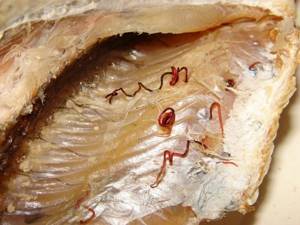
Parasitic worms in fish
We list the most dangerous of them:
- Siberian fluke. The size of the worm is 7-12 millimeters in length, the body has a whitish color. The Siberian fluke causes the disease opisthorchiasis.
- Chinese fluke. The size of the worm is 9-16 millimeters in length, the body has a whitish color. The Chinese fluke causes clonorchiasis.
- Wide tape. The worm can be up to 12 meters long; it looks like a grayish worm, the body of which thickens on the head side. The broad tapeworm causes the disease diphyllobothriasis.
- Trematode Nanophyetus schikhobalowi. The helminth has a body length of 0.52 to 0.58 millimeters, the body has a yellowish-gray color. The parasite Nanophyetus schikhobalowi causes the disease nanophyetosis.
- Trematode Metagonimus yokogawai. The helminth has a body length of 1-2.4 millimeters with a width of 0.4 to 0.7 millimeters. The parasite Metagonimus yokogawai causes the disease metagonimiasis.
- Anisakids. On average, helminths have a body length from 50 to 66 millimeters, the body of parasites is grayish in color. Anisakides cause the disease anisakiasis.
- Ordinary belt. The worm can be up to 120 centimeters long and the body is white. The common Ligulidae causes the disease ligulosis.
Methods of infecting humans: what kind of fish meat can contain active parasites?
Parasites can be present in most fish species consumed by humans, but only if the latter are not properly processed. It is also important to take into account that parasites differ in their specificity, which means that a certain type of parasite can only infect and remain invasive in certain types of fish.
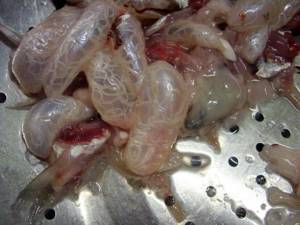
Helminths in the intestines of fish
You can become infected with opisthorchiasis by eating raw fish from the carp family. The most dangerous are ide, carp, rudd and bream.
Infection with clonorchiasis occurs when consuming insufficiently salted products of the following types:
- Amur chebak;
- delight belly;
- gudgeon;
- bitter;
- carp;
- Amur ide.
Infection with diphyllobothriasis occurs when consuming raw products of the following types:
- perch;
- ruff;
- burbot;
- Far Eastern salmon;
- pike.
Infection with nanophyetosis is possible when consuming insufficiently cooked or fried products of the following types:
- chum salmon;
- kunja;
- taimen;
- Amur broadmouth;
- Dolly Varden;
- Amur whitefish
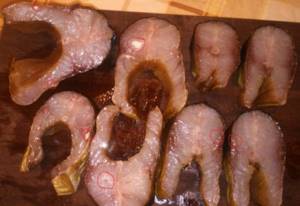
Larvae of parasites in fish meat
Infection with metagonimiasis is possible by consuming raw fish or its scales of the following types:
- trout;
- carp;
- crucian carp;
- Amur bream;
- Ussuri whitefish
Infection with anisakiasis is possible when eating predatory marine fish raw. This is the most common parasitic disease in Japan, since the traditional cuisine of this country involves eating raw sea fish.
Infection with ligulosis is possible when consuming the following types of fish raw:
- bream;
- vobla;
- roach;
- rudd;
- silver bream
How can you tell if there are worms in fish?
Contrary to popular belief, changes in the color of fish meat (darkening or yellowing) only in rare cases indicate that it is infected with worm larvae or mature parasitic individuals.
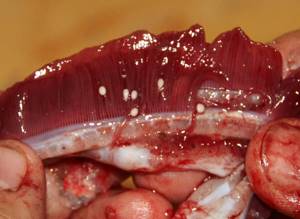
Worm larvae in fish
It is worth noting that some parasites or their larvae are simply impossible to see in meat due to their small size. In such cases, the contamination of meat can be confirmed only by performing a microscopic examination.
In other cases, it is enough to look at its insides when cutting the fish. It will not be difficult to notice parasites: sexually mature helminths look like ordinary worms, their larvae look like small balls or rings.
Unfortunately, it is extremely rare to find out whether there are worms in meat without cutting it. Only if the invasion is extensive can you notice with the naked eye that the fish’s belly is drooping (with characteristic lesions on it) or that there is a tumor on some part of the body. These signs indicate with almost 100% probability that the fish is infected with worms.
General classification of worms
Infectious disease specialists divide parasites in fish into those that are relatively safe for humans and those that are dangerous. Conditionally safe include:
- Helminths . Almost all types of helminths that parasitize fish do not cause anything other than eating disorders in humans. There will be no danger at all if, before preparing the dish, you remove the fish intestines and wash the carcass thoroughly. Next, the fish must be well cooked. In this case, you will get a tasty and healthy dish that will be completely safe.
- Cystidicolafarionis . This parasite is most often found in smelt, a fish of the salmon family. It is not dangerous to humans, but heat treatment must be carried out at the proper level.
- Schistocephalmoses in most cases infect crucian carp; this parasite does not pose a danger to humans, however, if pets become infected, this will lead to serious consequences, therefore, after cleaning the fish, the entrails must be properly disposed of, preferably buried.
- Trienophorus nodulosus is often found when cutting burbot, but it can also parasitize other species. It cannot cause any problems in humans if the fish is well thermally processed.
- Philometra parasitizes inside carp. It poses a great threat to freshwater inhabitants, but is safe for humans.
Parasites in fish that are dangerous to humans:
- Diffylbothryum dendriticum . Found in freshwater bodies of water. Fish is an intermediate host for this parasite; after the larvae enter the human body, they grow into a worm 1 m long.
- Diphyllobothriumalatum lives in the gills of burbot, perch and pike. In the human body, the larva develops into an adult up to 50 m long.
- Tapeworms in fish are also dangerous to humans. It can be found in different types of fish - herring, bream, roach, blue bream, pike and many others.
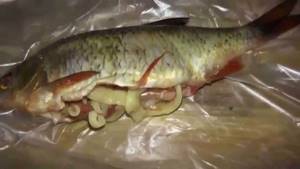
Tapeworm. You can't eat this kind of fish!
Wide tapeworm
The broad tapeworm is an insidious species of helminth, the largest of the parasites living in fish. Mainly freshwater carp and salmon become victims of this type of parasite.
Fish become infected by eating contaminated shellfish. The body of the worm resembles a long ribbon, hence the name of the species.
- A larva (ceracidium) moving independently in water and two parasitic stages (procercoid): in the cavity of mollusks, crustaceans, and then in fish - this is the life cycle of tapeworms.
- The tapeworm has oval yellow eggs. They develop in fresh water bodies. In a favorable environment (if the temperature is not lower than 15°C), the embryo begins to develop. In colder water it is viable for up to six months.
- The crustaceans swallow the larva, and the fish swallow the crustacean or smaller fish. After a month in the fish’s body, the larva grows to 5 cm.
- The helminths mature completely in the last host.
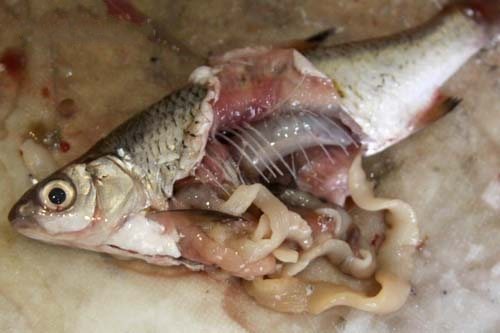
Infected fish have a swollen belly. When opened, the worm itself is revealed, but its larvae cannot be seen without special magnifying devices.
They live:
A person can become the final owner of the tapeworm if he eats infected fish that has not undergone long-term heat treatment. When frozen, tapeworm larvae survive.
If tapeworms are noticed when cutting fish, then it is advisable not to eat it, since there is a high probability of the presence of larvae in the meat. It is better to refuse such fish.
Cat fluke
This is the name given to flatworms - flukes. The parasites are small (their length does not exceed 18 mm), pale yellow in color. Helminths develop first in the body of mollusks and fish of the carp family.
Last owners: humans and animals, such as bears, that feed on raw fish. The cat fluke is viable for at least three decades, or even more, living in the human body. The worm got its name from the cat in whose liver it was first discovered at the end of the 18th century.
The fluke has female reproductive organs and male reproductive organs. Between them is a uterus full of small eggs. Worms are called flukes because of the suckers with which they cling to the walls of the owner’s organs.
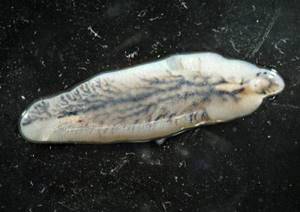
The cat (Siberian) fluke develops in several stages:
- Feces containing eggs from infected animals end up in the aquatic environment.
- They settle in the body of mollusks, develop and grow there for several months (up to 10). Then they leave the owner and find a new one.
- With the help of their tail, the larvae move freely in freshwater bodies and remain viable for up to 12 months.
- They penetrate the fish body through the skin, lose their tail and become overgrown with a shell.
- Together with infected fish, worms enter the human body if the fish meat has not been sufficiently processed.
In humans, the fluke settles in the organs of the gastrointestinal tract, such as the pancreas, bladder, and liver.
A person becomes infected with helminths by eating diseased fish: bream, rudd, roach. Infected people may not be aware that they have cat fluke in their bodies.
Trematodes belong to the class of flukes with a flat, leaf-shaped body covered with a membrane. Trematodes attach themselves to their nipples (those that live in the bloodstream do not have them).
Flukes have a complex life cycle. The intestines of mammals, fish, and birds are the place of their parasitism. At first, like other worms, they choose mollusks; then their owners are fish (sometimes there may not be a second intermediate owner).
- Adult parasites live in the intestines of fish-eating birds: herons, gulls and others. Bird feces with worm eggs end up in the water.
- Under favorable conditions, larvae hatch from them. With the help of cilia, they move, find the liver or gonad of the mollusk, and penetrate inside.
- The larvae shed their cilia and become immovable luggage that grows. It reaches a certain stage of development, bursts, and new larvae emerge, similar to worms. They do not have a tail or genitals.
- They free themselves from mollusks, move through the water, where they penetrate the body of the fish, settle in any of the organs (even the eyes), while losing their tail.
- By eating such fish, birds become infected. And only in their body the parasites reach sexual maturity, lay eggs, repeating the life phase.
How to determine the presence of opisthorchid in fish
The causative agent of the disease is the Siberian fluke. This is a small parasite, 7-12 mm in size, living in the bile ducts, pancreas or gall bladder. Before reaching humans, the parasite is in the body of mollusks or freshwater fish, the carp family - they are an intermediate link in the chain of infection. It is impossible to identify helminths in a carcass due to its small size. Opisthorchis and its larvae are clearly visible under a microscope. But this diagnostic method is only available in the laboratory. Ordinary citizens, in order to avoid becoming infected with opisthorchiasis, need to know at what temperature worms in freshwater fish die, since the larvae mainly infect representatives of the carp family.
You can determine whether a fish is infected by external signs:
- presence of spots, black spots, hemorrhages,
- dullness of scales,
- cloudy eyes,
- abdominal enlargement,
- disproportionate sizes.
When catching such individuals, you must discard the catch, since the fish may be infected.
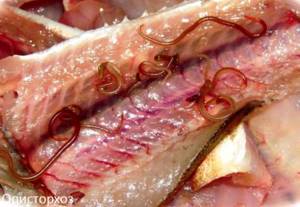
Beltworm
The Ligulp is the longest tapeworm (the length can reach more than a meter) that parasitizes fish. People call the yellowish-white parasite a tapeworm.
An individual that has not reached sexual maturity lives in the fish; the fish is an intermediate host. The last owner of helminths is birds that eat fish. It is in their intestines that the parasite will become sexually mature and ready to reproduce.
The most common victims of helminths are bream, but parasites do not disdain:
Living in fish, the worms feed on its juices and grow, squeezing the fish’s organs, causing their work to be disrupted.
Often, fishermen observed how bream floats on the surface of the water, unable to go to depth. It's all because of the parasite. Developing in fish, it damages its swim bladder.
You can eat such fish, you need to thoroughly clean it, rinse it, and cook it at a high heating temperature. It is possible that the taste of sick fish is inferior to healthy ones, since it could not fully feed and develop.
Philometra is a parasite that lives under the gills of fish of the carp family, and can live under the scales. Thin worms no more than 15 cm long are red. The presence of parasites is indicated by black spots on fish scales.
Red parasites are found:
The meat of infected fish falls apart and tastes unpleasant. To prevent parasites from harming human health after eating sick fish, it is first cleaned of worms, washed well, and cooked at a high heating temperature.
Worms are the most dangerous to humans, despite their small size (up to 5 cm long).
They settle in marine life:
Sometimes the parasites are called herring worms. Anisakids also live in cod, but they are smaller. Helminths have the same life cycle as other worms.
But not only adults can destroy their host, but even larvae. They bite into the intestinal walls of their owner, causing mechanical damage and destroying the functioning of organs. Their vital activity accumulates toxins that poison the body.
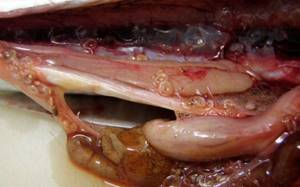
Diphyllobothriasis
Diphyllobothriasis is caused by tapeworm. It parasitizes in the human body for at least 10 years, but there are known cases of the helminth being in the small intestine for up to 40 years. During its life, pieces of the worm come out in the toilet.
People become infected with diphyllobothriasis if they eat raw or poorly cleaned and cooked fish.
Sometimes it is difficult to identify the disease. It occurs in different forms, but large parts of the parasite’s body are always visible in human feces.
The sick person may feel dizzy, feel weak, and have infrequent pain in the abdominal area. The disease can manifest itself 2 months after infection. Moreover, children get sick more severely than adults, although the clinical picture is the same.
Diphyllobothriasis affects the human body:
- mechanically;
- allergic, toxic;
- neuro-reflex.
Ulcers and atrophy form at the sites where the helminth attaches to the intestines. The functioning of the gastrointestinal tract is disrupted, anemia develops.
The disease is detected when visiting a doctor, during laboratory tests, blood tests and patient complaints. If the correct diagnosis is made and treatment is started, the person will fully recover.
The causative agent of the disease is a flatworm, the length of which is no more than 20 mm and the width up to 4 mm. Parasites live in the liver, bile ducts, and pancreas in animals and humans. If treatment is not started on time, the disease becomes chronic. The clinical picture is similar to the manifestation of opisthorchiasis.
The clonorchis worm or Chinese fluke is the causative agent of the disease. In the first six months after infection, the disease does not make itself felt.
Then symptoms appear, depending on the severity:
- The person has general weakness, diarrhea, and abdominal discomfort. This is a mild form of the disease.
- Poor appetite, stomach pain, fever, the patient is losing weight for no reason - signs of a moderate form of the disease.
- Sharp pain in the right hypochondrium, high temperature, the liver and spleen enlarge, become inflamed, the skin becomes covered with a rash, as the human body is poisoned by waste products of parasites. Symptoms indicate a severe form of the disease.
- Due to disruption of the liver and pancreas, diseases develop: pancreatitis, cholecystitis, cholelithiasis.
To prevent the dangerous disease clonorchiasis from acquiring a severe chronic form, it is necessary to consult a doctor in time, who will prescribe proper treatment.
The disease caused by Ligulidae larvae is ligulosis or tapeworm. Doctors consider the disease not too dangerous for people. A person feels a slight malaise, discomfort, loss of appetite. It is necessary to consult a doctor who will prescribe a course of treatment for helminths.
Parasites are visible to the naked eye. Infection can be avoided if the fish is cooked at high temperatures, cleaned and washed thoroughly.
Parasites of river fish and what to do with them
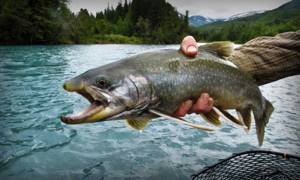
For some time now, there has been a strong trend in the world towards the popularization of such a strange diet as the “raw food diet”. Moreover, I come up with some pseudoscientific explanations like “more useful substances are preserved this way” and “this is how our biological ancestors ate, which means we should too.” And for some reason everyone forgets about the little parasites who are only happy if the fish and meat do not undergo specific processing.
Someone may object: “But in Japan, from time immemorial, they have been eating half-raw fish in sushi and nothing!” Yes. But the fish they ate there was predominantly sea, not river, and every second inhabitant of the Land of the Rising Sun was swarming with parasites. Personally, I'm not happy with this. Sensible people too, I suppose. Therefore, at a minimum, you need to know something about the parasites of river fish and about methods of preparing food that would completely eliminate them.
Biology
Let's start with some general information. We will consider various groups of flat and roundworms as the main parasites of river fish. They are the ones who most often choose to interact with other living beings. It is also worth knowing that creatures that are very primitive from a biological point of view usually have a complex development cycle, involving several intermediate hosts.
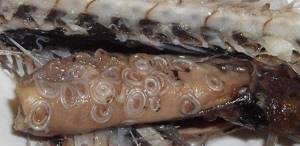
It looks like this: the mature form, living in the intestines of the carrier, lays eggs that enter the environment. The eggs are small and there are extremely many of them. By accident and on purpose, they are swallowed by the first intermediate carrier. Due to the strong outer shell, they are not afraid of digestive enzymes, therefore, after some time, larvae (also very, very stable) hatch in the intestines of the intermediate carrier, penetrate through the walls of blood vessels and are carried through the tissues of the body. And then - depending on your luck. Some species live peacefully in the liver, eat it, and when ripe, exit with bile. And some are carried into other tissues of the body, where it is no longer possible to live almost unnoticed.
In the course of their life, parasites of river fish secrete a number of substances designed to suppress the human immune system. They usually succeed. In addition, some of their waste products are toxins that cause a general reaction in the body. They also eat what we eat and ourselves. It's all very fun, though. But these are general words because each specific parasite may have its own characteristics. And now we will talk about them.
Diseases and features
- Opisthorchiasis . A disease caused by liver flukes of various types. As the name suggests, it mainly affects the liver and bile ducts. This parasite of river fish two intermediate hosts - the freshwater mollusk Bithinia (in appearance, it looks like an ordinary pond snail) and fish of the carp family, which feed on these Bithinia. The greatest risk is posed by ide, bream, dace, roach, rudd, carp, tench, asp and some other freshwater fish. Clinical manifestations begin 2-3 weeks after eating infected fish. They are nonspecific - general weakness, nausea, fever up to 38 and above (sometimes), indigestion, plus intolerance to fatty foods (bile = breakdown of fat, and the bile ducts are clogged with flukes) and pain in the right hypochondrium.
- Clonorchiasis . Called Chinese fluke. The clinical manifestations are very similar to opisthorchiasis, but the carrier fish are slightly different - Amur ide, gudgeon, carp, crucian carp and other fish caught in the rivers of the Far East.
- Diphylbothriasis . Caused by broad tapeworms. Yes, these are the same multi-meter worms that are found in the intestines. First they live in small copepods, then in the muscle tissue of perches, ruffes, pikes and salmon fish. Clinical manifestations are again nonspecific. Weakness, flatulence, a feeling of heaviness in the stomach, irritability, and sometimes an allergic rash.
- Nanophyetosis . It is caused by tiny trematodes (one and a half millimeters in length), which settle in the small intestine. Clinical manifestations are incessant and persistent diarrhea, weakness, and in the long term - anemia. The carriers of this parasite of river fish are chum salmon, Amur whitefish, grayling, minnow, Amur broadmouth and some other fish, again from the rivers of the Far East.
- Anisakiasis. A challenge to those people who shout that “there are no parasites in sea fish!” There are. That's how it happens. Cod fish, herring, salmon, perch - these small harmful nematodes live in all of them. The clinical picture is a typical gastrointestinal disorder.
- Ligulosis. Another flatworm, for which the intermediate habitat is the intestines of fish such as bream, roach, rudd, silver bream and roach. Fortunately, it’s difficult not to notice this hefty worm, and people usually don’t eat fish guts. And if you gut the fish, then there is nothing to fear. Except that contaminated fish is not as tasty and nutritious as healthy fish.
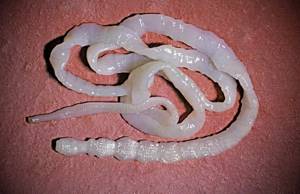
Treatment
It is not as difficult to destroy the parasites of river fish as to kill their larvae and eggs. The fact is that they are damn resistant to almost any environmental influences. Therefore, any culinary processing must be either extreme or quite long. So.
- Cooking. Minimum 15 minutes, but better 20 after the water boils.
- Frying. Likewise, it is better to cut large pieces so that the meat is heated evenly.
- Smoking. The main thing is to maintain the allotted time. By the end of it, all potential parasites will be destroyed. We will tell you more about this method of preparing fish in other articles.
- Ambassador. The weight of salt should be 20 percent of the initial weight of the fish. Either dry or wet salting, small fish are considered safe after 13 days of processing. With hot salting, when the temperature is also added, the time frame is slightly lower - 9 days. As for large fish, it is better to either salt it in pieces or increase the estimated time by 2 times.
- Freezing. It all depends on the temperature. When deep frozen (-40 degrees), fish is considered safe after 12 hours. And with usually very cold (down to -4 degrees) - only after 15 days.
Some sources provide time ranges, that is, the minimum time needed to completely destroy parasites of river fish , but I do not think this is advisable, since there is still a risk that a particularly tenacious infection will last a minimum period. It’s better to wait a little longer, but be one hundred percent sure.
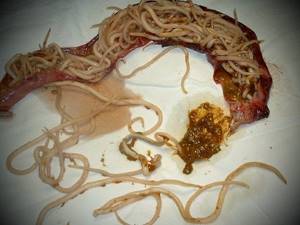
What to do if, despite all the precautions, you feel that a new life is beginning to develop in you? Visit a doctor. Fortunately, humanity has become quite adept at killing parasites with drugs, so most parasitic infections can be cured with pills. Another thing is that there will still be consequences for the body - changes in the liver, weakened immunity, persistent allergization, or something worse.
So think twice about whether it’s worth risking your health for the sake of a newfangled hobby or as a result of blatant negligence. There is, however, another option - fish grown on special farms. There will definitely be no parasites in it, since they monitor this extremely strictly. But can you be sure that it was from this fish that the very sushi that stands in front of you on the table was made?
Opisthorchiasis
Opisthorchiasis is one of the dangerous diseases, the causative agent of which is the cat or Siberian fluke. A flatworm or fluke lives in the pancreas and bile ducts. Sometimes found in the liver and gall bladder.
Worms and larvae enter the human body not only after eating diseased fish. Even those who clean an infected carcass are at risk, since the larvae are small and difficult to see.
- The disease has a latent period of 21 days. The initial phase of the disease occurs without symptoms. You feel weakness, malaise, increased sweating, and sudden increases in temperature.
- Later, the infected person constantly has a headache, discomfort in the abdomen, developing into pain that becomes more frequent and stronger. Then the desire to eat disappears, nausea, loose stools or constipation.
If the diagnosis is correct and treatment is started, the person will fully recover.
It is undesirable to delay consulting a doctor in order to avoid complications that can lead to serious consequences, such as cirrhosis of the liver.
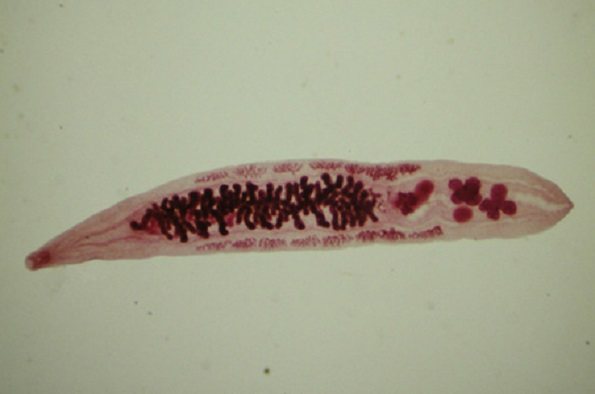
Worms dangerous to the human body
Among all of the above infection carriers, Diphyllobothrium latum and Diphyllobothrium dendrite should be distinguished. The favorite fish of these worms are perch, pike, burbot, as well as their derivatives: caviar, liver, etc.
Worms of the nematode group, the size of which does not exceed 5 mm, are also at risk. The symptoms of infection with these parasites are similar to all others: diarrhea (or, conversely, constipation), bloating, nausea, gastrointestinal dysfunction. If you find this kind of worms inside a fish, get rid of it, since no heat treatment will help in this case.
We recommend reading:
Immigration to Germany for permanent residence from Russia
The most susceptible fish species to infection
Not all fish species, both marine and freshwater, are equally susceptible to infection by various parasites. The most susceptible species susceptible to parasite infection include:
- Crucian carp . Living in the middle zone, this common inhabitant of various bodies of water rarely causes infection. Living within the Far East, this fish often becomes the object of infection with clonorchiasis.
- Yazya . It is believed that ide is an omnivorous fish, therefore it is most susceptible to infection by the Siberian fluke, which can cause many dangerous ailments.
- Bream . Living in the middle zone, as well as in warmer regions, this fish is a carrier of ligulosis.
- Perch , eating which without careful processing can become infected with ligulosis and diphyllobothriasis. Diphyllobothrium latum larvae are found in the gills of fish. This parasite poses a serious threat to human health.
- Linya . As a rule, this fish lives in reservoirs with dense thickets of aquatic vegetation, as well as a muddy bottom. In such conditions, the cat fluke develops well, which can cause a disease such as opisthorchiasis.
- Pollock . This seafood, which is often found on store shelves, can infect a person with anisakiasis, a very dangerous disease.
- Flounder . Many helminths can live in this fish, so it is generally not recommended to eat it without heat treatment.
Note to the hostess! Preparing dishes from the above-mentioned fish species requires high-quality heat treatment. These types of fish are not recommended to be consumed lightly salted, and especially raw.
Parasites in the liver of burbot
Burbot is one of the valuable commercial fish. The caviar and liver of this species are considered real delicacies due to their delicate taste and significant nutritional value. However, when preparing and eating dishes from burbot liver, one should not forget about the risk of infection by parasites that may live in this organ.
Parasitoses of burbot
This type of fish lives in fresh water bodies and leads a bottom-dwelling lifestyle. This determines the list of helminths that live in it as a final or intermediate host.
At the moment, about 10 species of parasites have been identified that live in the body of burbot, and most of them, at different stages of development, enter the liver along with the bloodstream or by gnawing through the parenchyma.
Three parasitoses are found most often in this species:
- trienophorosis;
- diphyllobothriasis;
- opisthorchiasis.
Trienophorosis
This disease in burbot begins after a larva or mature individual of the parasite Triaenophorus nodulosus enters the body. Infection occurs only in the warm season, since development and reproduction are suspended in cold water.
After migrating throughout the body, the larvae enter the liver parenchyma. Inside the tissue they build up fibrous tissue, which looks like white beads of different sizes, but no more than 1-2 mm. With severe disease intensity, the entire liver appears affected. When the plaques are cut, serous tissue appears, similar to fat.
Most often, burbot infection occurs at the fry stage. If many of these fibrous plaques develop in the liver, the fry or young fish of the current year may die. In older fish, severe weight loss occurs, the belly swells, and the mucous membranes become pale.
The taste qualities of such liver are sharply reduced: it loses its fat content and does not have a sweetish taste. However, the affected areas can be cut out and cooking can continue.
Diphyllobothriasis
The causative agent is the broad tapeworm. Burbot is an intermediate host for it, so only immature individuals are found in the liver. This parasite is clearly visible even with the naked eye: if the fish has not been frozen, then slowly moving worms 2-10 cm long can be seen in it. In addition to this organ, the wide tapeworm can live in the esophagus, stomach, muscles, etc.
In most cases, the parasite does not lead to the death of the host, but the fish becomes skinny, inactive, and may be affected by concomitant diseases due to decreased immunity.
Opisthorchiasis
The disease is caused by the trematode Opisthorchis felineus. Their eggs end up in fresh water bodies along with animal feces, but can be carried over long distances by currents.
Parasites settle in the bile ducts of burbot, which causes congestion in the liver. It becomes darker, enlarged, and in later stages is affected by cirrhosis. The fish is poisoned by toxins and allergic reactions begin. In the liver and muscle tissue of burbot, capsules may appear that are difficult to cut. Worm larvae are found inside the cysts.
Danger to humans
Not all of the above parasites pose a danger to human health. Some do not develop after being eaten, but are simply excreted in the feces.
The dangerous disease diphyllobothriasis, if left untreated, can cause complete exhaustion or even death. There are known cases where helminths of this species lived in the gastrointestinal tract for 25 years.
A sexually mature individual can block the intestinal lumen, cause toxic-allergic reactions, vitamin deficiencies, ulcers of the intestinal walls, etc. The functions of the digestive system and other organs may be disrupted.
The patient becomes weak, appetite is impaired, weight decreases, and the blood count deteriorates. Dizziness, tinnitus, and headaches often occur. All symptoms intensify if the body is parasitized by not one worm, but several at once. Treatment is carried out in a hospital. The patient is prescribed anthelmintic drugs and at the same time they are fighting other symptoms.
Another disease that can appear after eating burbot liver is opisthorchiasis. Approximately half a month to a month after infection, a high temperature rises, insomnia and headaches occur. The skin may become yellowish and the lymph nodes become enlarged. Epigastric pain and digestive disorders often develop.
In the chronic course, signs of gastritis, gastric ulcers, duodenitis, and cholecystitis appear. Treatment is carried out by taking anthelmintic drugs and restoring digestive function.
Prevention
In most cases, infection occurs due to the consumption of burbot without proper preliminary thermal preparation. To protect yourself, the fish is frozen. The freezing period depends on the temperature:
- -40°С – at least 7 hours;
- -35°C – at least 14 hours;
- -28°C – at least 32 hours.
Proper salting also solves the problem, but salted liver is rarely included in recipes. However, you need to know the norms and timing of salting: with a solution salinity of 14%, the liver must be kept for at least two weeks.
The safest option is thorough frying or other heat treatment before use. You should also pay attention to the condition of the liver: if it is healthy, then its parenchyma is dense and pink. In sick fish it is loose, heterogeneous, reduced or increased.
Source: https://ParazityCheloveka.ru/parazity/parazity-v-pecheni-nalima.html
How to protect yourself from parasite infection
Knowing that fish can contain various parasites, you should adhere to the cooking technology, subjecting the fish to heat treatment. Such technologies include:
- Cooking.
- Frying.
- Hot smoking.
- Deep ambassador.
- Deep freezing.
If the fish is cooked for at least 20 minutes, then any type of parasites will die in it. If you fry fish, this is another fairly effective way to get rid of parasites, since the temperature is higher than when boiling. Hot smoking also allows you to neutralize parasites, but the duration of treatment should not be less than 2 hours.
In addition to temperature treatment, there are two more options that can protect a person from helminth infection - deep salting and deep freezing. Salt destroys all types of parasites within 2 weeks. If large fish is used for salting, then the processing time should be increased.
Parasites can also be destroyed by deep freezing at a temperature of -40 degrees. In such conditions, the parasites die within 24 hours. Before such a technological procedure, the fish is thoroughly washed under running water.
As you can see, there are enough ways to disinfect fish, so it is not problematic to use any of them.
Recently, it has become fashionable to eat fish without proper temperature treatment, since in such dishes most of the beneficial components, such as minerals and vitamins, are preserved. But then you need to be 100 percent sure that the fish meat does not contain parasites, otherwise healthy food will turn into serious health problems after some time.
It is possible to defeat parasites!
Antiparasitic Complex® - Reliable and safe removal of parasites in 21 days!
- The composition includes only natural ingredients;
- Does not cause side effects;
- Absolutely safe;
- Protects the liver, heart, lungs, stomach, skin from parasites;
- Removes waste products of parasites from the body.
- Effectively destroys most types of helminths in 21 days.
There is now a preferential program for free packaging. Read expert opinion.
Interesting to know:
Bibliography
- Centers for Disease Control and Prevention. Brucellosis. Parasites. Link
- Corbel MJ Parasitic diseases // World Health Organization. Link
- Young EJ Best matches for intestinal parasites // Clinical Infectious Diseases. — 1995. Vol. 21. - P. 283-290. Link
- Yushchuk N.D., Vengerov Yu.A. Infectious diseases: textbook. — 2nd edition. - M.: Medicine, 2003. - 544 p.
- Prevalence of parasitic diseases among the population, 2009 / Kokolova L. M., Reshetnikov A. D., Platonov T. A., Verkhovtseva L. A.
- Helminths of domestic carnivores of the Voronezh region, 2011 / Nikulin P. I., Romashov B. V.
An article for patients with a doctor-diagnosed disease. Does not replace a doctor's appointment and cannot be used for self-diagnosis.

The best stories from our readers
Topic: Parasites are to blame for all troubles!
From: Lyudmila S. ()
To: Administration Noparasites.ru
Not long ago my health condition worsened. I began to feel constant fatigue, headaches, laziness and some kind of endless apathy appeared. Problems also appeared with the gastrointestinal tract: bloating, diarrhea, pain and bad breath.
I thought it was because of the hard work and hoped that it would go away on its own. But every day I felt worse. The doctors couldn’t really say anything either. Everything seems to be normal, but I feel like my body is not healthy.
I decided to go to a private clinic. Here I was advised, in addition to general tests, to get tested for parasites. So in one of the tests they found parasites in me. According to doctors, these were worms, which 90% of people have and almost everyone is infected, to a greater or lesser extent.
I was prescribed a course of antiparasitic medications. But it didn’t give me any results. A week later, a friend sent me a link to an article where some parasitologist shared real tips on fighting parasites. This article literally saved my life. I followed all the advice that was there and after a couple of days I felt much better!
Digestion improved, headaches went away and the vital energy that I so lacked appeared. To be sure, I took the tests again and no parasites were found!
Anyone who wants to cleanse their body of parasites, no matter what types of these creatures live in you, read this article, I’m 100% sure it will help you! Go to article>>>
Still have questions? Ask them in our Anonymous group on VK
How to get rid of parasites in a week. The answer is here!
A reliable and effective remedy for combating worms. Removes all parasites in 21 days.
Go to website
Reviews
Read online
Symptoms that 100% indicate parasites! Take the Test.
How to rid your body of life-threatening parasites before it’s too late!
Read more
Website
To get a consultation
The doctor tells how to quickly get rid of parasites for adults and children!
A parasitologist explains what effective methods exist to combat helminths.
More details
Read completely
Comments
Search for cures for parasites
This service is a small help in finding cures for parasites. To start using it, select the type of parasite. If you don’t know what kind of parasite you are infected with, this parasite identification tool will help you by symptoms.
We recommend reading

Toxoplasmosis in dogs: routes of infection, symptoms and treatment
01/29/202102/01/2021ecoliv94
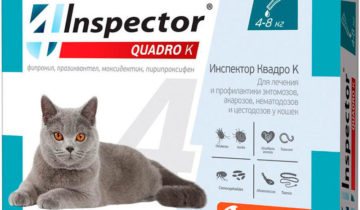
Worm inspector for cats: instructions for use, cost
01/27/202102/02/2021ecoliv94

Products for cats against ticks and worms: list of the best
01/25/202102/3/2021ecoliv94

Dirofen against worms for cats and dogs: instructions for use, price, analogues
01/25/202102/3/2021ecoliv94
